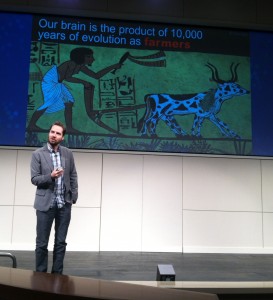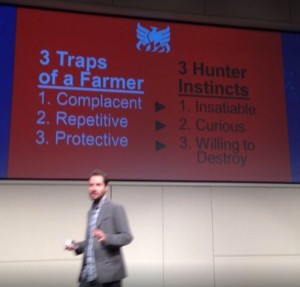We live in a world where chaos is increasingly the norm. And human nature when faced with chaos normally triggers a protective reaction - it could be a retreat, "circling the wagons," or other moves to preserve and protect. It's understandable, but in the world of business that reaction may also translate into missed opportunities. That is one premise that "Trend Hunter" Jeremy Gutsche and author of "Exploiting Chaos" holds near and dear.
 Gutsche posits that almost all innovation happens by making connections between fields that people did not previously recognize, and with the descriptions he offers, it really makes sense. I really get his point, but few business situations are simple to the point that you can attribute success to a connection made. What's meaningful is to consider examples of opportunities missed because the right people either were unable to imagine the connection(s) or were too vested in the status quo to change with the times.
Gutsche posits that almost all innovation happens by making connections between fields that people did not previously recognize, and with the descriptions he offers, it really makes sense. I really get his point, but few business situations are simple to the point that you can attribute success to a connection made. What's meaningful is to consider examples of opportunities missed because the right people either were unable to imagine the connection(s) or were too vested in the status quo to change with the times.
Examples he cites include Smith-Corona typewriters, Blockbuster home movies, and Encyclopedia Brittanica. And then along came word processing, online video streaming and Wikipedia. in the case of Smith-Corona, they were one of the first to develop innovative text tools such as "spellcheck," but decided instead to focus on being the best typewriter company in the world. But who do you know that still uses a typewriter?
His point is that patterns surround us - they're everywhere, and the challenge is first to detect the patterns and then to discern the ones that either hold the gold key or that will pull the rug out from under you. It's just that simple -right? If that were only so.
Gutsche's opinion is that our brains are the product of 10,000 years of evolution as farmers - once you have a successful product, you're pre-wired to keep repeating the success over and over. And there is nothing to disparage about farming - the development of agriculture is what laid the bedrock for modern civilization after all. But while we have made so many great strides we still live in a world that's not a stranger to hunger and famines. And his point is that that focusing too much on making improvements in the predictable realm of "farming" may cause you to miss the bigger opportunities that a hunter would recognize.
Consider Victoria's Secret in two ways - one as a $1M opportunity realized, and also as a $5.999B opportunity missed. Both are equally valid.
Victoria's Secret was founded in San Francisco by Roy Raymond with $80,000. in 1977 as a "store where men could feel comfortable buying lingerie" (ostensibly for their lady friends). He grew his initial success into 4 bricks-and-mortar locations and a catalogue operation and then sold it in 1982 for a cool $1M - a success by many standards. But then the buyer, Les Wexner, founder of Limited Brands, saw a very different opportunity in Victoria's Secret. He quickly repositioned it as a store focused on making women feel good and grew it into the $6B dominant retailer of women's lingerie it is today - earning every cent of the $5.999B in value he created.
 To Gutsche, the traps of a farmer are to be repetitive, protective and complacent. The winning instincts of a hunter, on the other hand, are to be curious, insatiable and willing to destroy. Les Wexner was willing to destroy Roy Raymond's "lingerie-safe-for-men-to-buy" farm and hunt down every woman in America that wanted to feel good about wearing lingerie. We can see what happened with that.
To Gutsche, the traps of a farmer are to be repetitive, protective and complacent. The winning instincts of a hunter, on the other hand, are to be curious, insatiable and willing to destroy. Les Wexner was willing to destroy Roy Raymond's "lingerie-safe-for-men-to-buy" farm and hunt down every woman in America that wanted to feel good about wearing lingerie. We can see what happened with that.
With chaos increasingly becoming the norm, the trick is to awaken your inner hunter. The key is to exploit chaos to compete effectively.
Gutsche feels that one of the best ways to become a hunter is to push data and see things that others don't see.
Thanks to Visual Analytics, which brings the power of data visualization right to where big data lives in your operation, you have an unprecedented ability to see what others might not see.
Other golden nuggets he offers include that we should become irresistible to specific groups of people. So we should differentiate - but do it in a way that your market values. Also, we should break free of past successes because they tend to anchor us too strongly in the past. And don't fight an unstoppable force, but redirect that force to your advantage and avoid confronting a competitor head-on, instead look at the opportunities they create around them.
Gutsche also counsels others to be genuinely interested in people, and know that there is always upside in times of difficulty. Even in chaos, you can channel momentum to your advantage - and your breakthrough exists in some combination that you just haven't seen yet. So don't ever stop looking for new combinations.
---------
Jeremy Gutsche delivered the keynote address at the SAS Financial Services Executive Summit on May 1, 2014.
